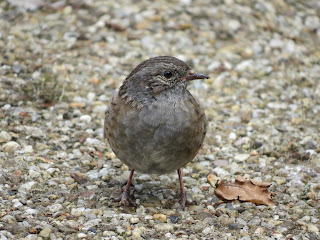Living everyone's fantasy
Its been years since I've been to Benacre, maybe decade or more, which considering its not that far from where I live, is a long time. I don't know maybe because its just easily over looked, its a very humble reserve which never advertises itself at all, but its never on my birding schedule.
My brother was still with us in Suffolk, and we've been exploring reserves in the county, and eventually with most of them visited there was really only really Benacre left, selected by default.
Covehithe Church where we parked, with it's ruined nave
When we arrived at Covehithe the omens weren't great, it was so busy with people. Strong southerly winds had created a beautiful sunny day, making it closer to August than October. As a result everybody understandably wanted a part of it. However as is often the way, the further you get from a car park, the less people there are, and we soon left the people behind.
So we took the footpath to the beach and Covehithe Broad. There was nothing on that body of water, simply because of the large number of people there. I don't think it would be bad to put up a fence to keep people out, I mean it wouldn't do any harm, wildlife needs some room as well. Sometimes birdwatching clashes with holiday makers, but its simply the majority of people don't know about it, there are few signs about notifying people this is a nature reserve.
One of the fun things at Benacre is to see what's fallen off the cliff onto the beach
We walked north along the beach to Benacre, following the sandy cliffs. The broad had actually barely changed since I last came, it was pretty much an estuary with a large area of wet mud. Its good to see the old hide is still there despite been twenty plus years old.
On the broad was a smattering of ESTUARINE WADERS: 20+ RINGED PLOVERS, GREY PLOVERS, KNOTS, CURLEW, DUNLIN, REDSHANKS and OYSTERCATCHER. There were only a few DUCKS, some TEAL and MALLARD.
So we wound our way back to Covehithe, where we saw a STONECHAT, a species that is having a great Autumn. There were also four PIPIT SP., monosyllabic, and a dark brown/green colour with a distinctive white elbow, your typical LBJ.
To be honest not many birds to photograph today, so lots of pictures of the beach
As made our way down to Easton Broad, out at sea large flocks of BRENT GEESE were flying south, low over the water.
The broad was like Covehithe and fairly quiet. In the reedbeds there were several small flocks of BEARDED TITS, which we were to see all across the extensive reedbed, along with REED BUNTINGS and a quatering MARSH HARRIER.
To the south of Easton Broad we took a track inland that skirted the huge area of reedbeds. In the area of set aside in the framlands, there were SKY LARKS, YELLOWHAMMERS and MIPPITS, quite good as we hadn't seen many small birds up till then.
We took the track on to a road and then we hit the footpath to the west of Easton Broad. This footpath had been closed due to a broken boardwalk. We decided to give it a go, I mean how wet can it get? The path was overgrown and we had to watch everystep, as though the boardwalk was still present it tended to be missing in places, in others the wood broke under step and I nearly fell into the mud. In the end we decided to take a path where the reedbed met the farmland.
The day's weather was more akin to August
After that the footpath just went thorugh uninteresting farmland and we saw few other birds. A large flock of several hundred STARLINGS were feeding amongst the pig fields, but that was about it.
So it wasn't a particularly great day, or even one that was memorable, but that's what you expect when you get away from the main reserves. Okay so it may be less time than a decade before I come back here, but to be honest I don't rate Benacre, as important a reserve as it is, as a top birding destination, and there are more places that deserve my attention.




















